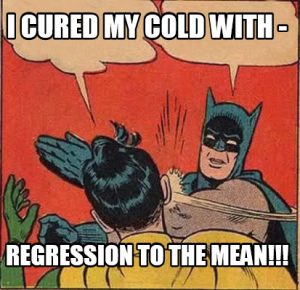
Knowing that a treatment works on average for a group of patients doesn’t tell you whether it will work for the patient in front of you. NICE recommends both cognitive behaviour therapy (CBT) and antidepressant medication for patients with moderate to severe depression (NICE 2009). We know that on average CBT and antidepressants work equally (and moderately) well for depression (Cuijpers et al, 2013).
What we don’t know is whether these averages hide that some people have really good responses and some people have really bad responses. Personalised medicine aims to tackle this, and its supporters say we need to focus “on individual, not average, responses to therapy” (Schork, 2015).
This study by Jeffrey Vittengl and colleagues published in the American Journal of Psychiatry included adults with moderate-severe depression undergoing CBT or taking medication. It aimed to find out:
- How often people had negative or especially positive outcomes
- What predicted negative or especially positive outcomes

This new review looked at negative and positive responses to treatment for depression, and what predicted different outcomes.
Methods
1,700 participants from 16 randomised controlled trials (RCTs) were included. These RCTs compared CBT and medication for depression. In each trial, there were pre-treatment and post-treatment measures of depression: the Hamilton Rating Scale for Depression (HAM-D), the Beck Depression Inventory (BDI), or both. The HAM-D is completed by clinicians and the BDI is completed by participants.
Participants’ outcomes were characterised as:
- Deterioration (increase ≥1 HAM-D or BDI point)
- Reliable deterioration (increase ≥8 HAM-D or ≥9 BDI points)
- Extreme non-response (post-treatment HAM-D score ≥21 or BDI score ≥31)
- Superior improvement (HAM-D or BDI decrease ≥95%)
- Superior response (post-treatment HAM-D or BDI score of 0)
Demographic and clinical predictors were analysed using multilevel modelling. This is a regression-based analysis that can take into account the random effects that occur because data is taken from 16 separate studies.
Demographic features that were examined included age, gender, ethnicity, education level and full-time employment.
Clinical features included pre-treatment depression severity and specific depressive symptoms such as insomnia.
Results
The results from the HAM-D and BDI were moderately highly correlated (r = 0.85) but there were some discrepancies.
1. How often people had negative or especially positive outcomes
Negative outcomes
- 5-7% of people showed any deterioration
- 1% of people showed a reliable deterioration
- 4-5% of people showed an extreme non-response
Positive outcomes
- 6-10% of people showed superior improvement
- 4-5% of people showed a superior response
When comparing CBT to medication
- There was no difference in the number of people who showed a deterioration, extreme nonresponse or superior response
- Participants who had medication were more likely to have a superior improvement as rated by clinicians (HAM-D) but not by patients (BDI), but were also more likely to drop out of trials
2. What predicted negative or especially positive outcomes
- Lower pre-treatment depressive symptoms predicted deterioration on the HAM-D and BDI
- BUT lower pre-treatment BDI scores also predicted superior response on BDI
- Higher pre-treatment depressive symptoms predicted extreme non-response
- BUT higher pre-treatment HAM-D scores also predicted superior improvement on the HAM-D
- Younger age predicted superior improvement (HAM-D only)
- Full-time employment predicted superior response (BDI only)
Eight studies provided individual scale item scores for the HAM-D
- Lower pretreatment depressed mood, less guilt and fewer somatic symptoms predicted any deterioration
- Insomnia and weight loss predicted extreme nonresponse
- Gastrosomatic symptoms predicted superior improvement.

Pre-treatment symptom levels helped forecast negative AND positive outcomes, but did not guide selection of CBT vs antidepressants.
Conclusions
The authors concluded:
Deterioration and extreme nonresponse and, similarly, superior improvement and superior response, both occur infrequently in randomised clinical trials comparing CBT and pharmacotherapy for depression. Pretreatment symptoms levels help forecast negative and unusually positive outcomes but do not guide selection of CBT versus pharmacotherapy.
Strengths and limitations
This was a large study that helped to quantify the number of people who get worse and the number of people who have superior responses when receiving CBT or medication for depression. However, there are a number of details about the 16 RCTs that are not addressed. It is unclear what medications were taken by participants in the ‘pharmacotherapy’ groups. It is also not clear how long it was between participants filling out the pre-treatment and post-treatment depression scales. The study addresses these differences in some ways by using a multilevel analysis, recognising that participants are nested in 16 separate studies.
Another possible difficulty in interpreting the results is the statistical phenomenon of regression to the mean (see Yudkin & Stratton, 1996). This is the principle that if people are selected for scoring highly on a variable (depression in this study), the score on re-measurement (i.e. post-treatment) will be lower than the starting mean. Conversely, if people in a group have a starting score that is near to the mean of the group, they are more likely to have a more or less extreme score (i.e. further from the mean) when they are re-measured. We see this in the finding that lower pre-treatment depression scores predicted both deterioration and superior response on the BDI. Also, higher pre-treatment scores predicted both extreme nonresponse and superior improvement on the HAM-D. The natural course of major depressive disorder is bouts of depression punctuated by periods where the individual does not meet criteria for depression. In a study of the course of depression in over 7,000 people (the Netherlands Mental health Survey), the mean duration of a major depressive episode was 3 months (Spijker et al, 2002). Without data on deterioration and superior responses in a placebo-control group, it is difficult to estimate how much the outcomes are affected by this phenomenon of regression to the mean.
This study also does not clarify whether patients who showed deterioration would have shown improvement if they had been in the other arm of the trial. For example, if someone deteriorated undergoing CBT, would they have improved with medication, or vice versa.

Regression to the mean is a statistical phenomenon that can make natural variation in repeated data look like real change.
Summary
This study highlights that therapies for depression can have very varied outcomes. Some patients may show huge improvements, while others may find that their depression worsens. Clinicians should be vigilant for patients who are showing signs of deterioration and consider prompt switching to another type of treatment once the patient has tried the initial therapy for long enough to expect an improvement. Unfortunately the predictors that were identified (pre-treatment depression scores, age and full-time employment) are difficult, if not impossible, to modify.
Further research should aim to clarify factors predicting deterioration or superior improvement that are specific to CBT and medication so that participants can be started on an initial treatment regimen that is most likely to minimise deterioration rates and maximise superior response rates.

Clinicians should look out for signs of deterioration in patients and consider switching treatment if there is no improvement.
Links
Primary paper
Vittengl JR, Jarrett RB, Weitz E, Hollon SD, Twisk J, Cristea I, David D, DeRubeis RJ, Dimidjian S, Dunlop BW, Faramarzi M, Hegerl U, Kennedy SH, Kheirkhah F, Mergl R, Miranda J, Mohr DC, Rush AJ, Segal ZV, Siddique J, Simons AD, Cuijpers P. (2016) Divergent Outcomes in Cognitive-Behavioral Therapy and Pharmacotherapy for Adult Depression. Am J Psychiatry. 2016 May 1;173(5):481-90. doi: 10.1176/appi.ajp.2015.15040492. Epub 2016 Feb 12. [Abstract]
Other references
Cuijpers P, Berking M, Andersson G. et al (2013) A meta-analysis of cognitive-behavioural therapy for adult depression, alone and in comparison with other treatments. Can J Psychiatry 2013 58, 376-385. [Abstract]
NICE (2009) Depression in adults: recognition and management. NICE CG90, Last updated Apr 2016.
Schork NJ (2015) Personalized medicine: Time for one-person trials. Nature 2015 520, 609-611.
Spijker J, de Graaf R, Bijl RV. et al (2002) Duration of major depressive episodes in the general population: results from The Netherlands Mental Health Survey and Incidence Study (NEMESIS). The British Journal of Psychiatry 2002 181(3) 208-213.
Yudkin PL, Stratton IM. (1996) How to deal with regression to the mean in intervention studies. The Lancet 1996 347, 241-243.

good to see #batman protecting us all from regression to the mean ;) @Mental_Elf
One size does not fit all: divergent outcomes from CBT and antidepressants for depression https://t.co/8oqmMlthfL
Today @Suzanne_Dash on Divergent Outcomes in CBT and Pharmacotherapy for Adult Depression https://t.co/ptuOhzRQ0v
One size does not fit all divergent #outcomes from #CBT & #antidepressants for #depression https://t.co/saAVyZJm1z @Mental_Elf on a big #RCT
One size does not fit all: divergent outcomes from CBT and antidepressants for depression https://t.co/5Me3rZYTiO via @sharethis
Regression to the mean
Nice mention of this in our blog today by @Suzanne_Dash
https://t.co/ptuOhzRQ0v https://t.co/gwrNbLP9S8
An excellent summary that everyone should take into account when looking for ways to treat depression – no single method works for everyone, and there are a variety of factors that need to be considered before you can find the best treatment for yourself. In many cases, it is never just one, but a combination of many different products – lifestyle changes, medication, physical exercise etc. – that lead to a better lifestyle, mental-health wise.
Don’t miss:
One size does not fit all
Divergent outcomes from CBT and antidepressants for depression… https://t.co/vGDbqOYN4U
@Mental_Elf Is it reasonable to think then, that people can recover despite, rather than because of the NICE guideline treatment?
[…] greatly or deteriorate as a result of a treatment, interventions can be better personalised. This article explains the findings of a research paper which explores that idea. Outcomes are divergent. Worse […]
Hi. In your summary you state: “This study highlights that therapies for depression can have very varied outcomes.” Should this state “CBT” rather than a blanket “therapies” based on the paper being discussed?
[…] et al., 2010; Cuijpers et al., 2010a; Cuijpers et al., 2010b). This phenomena was described in a Mental Elf blog from last […]